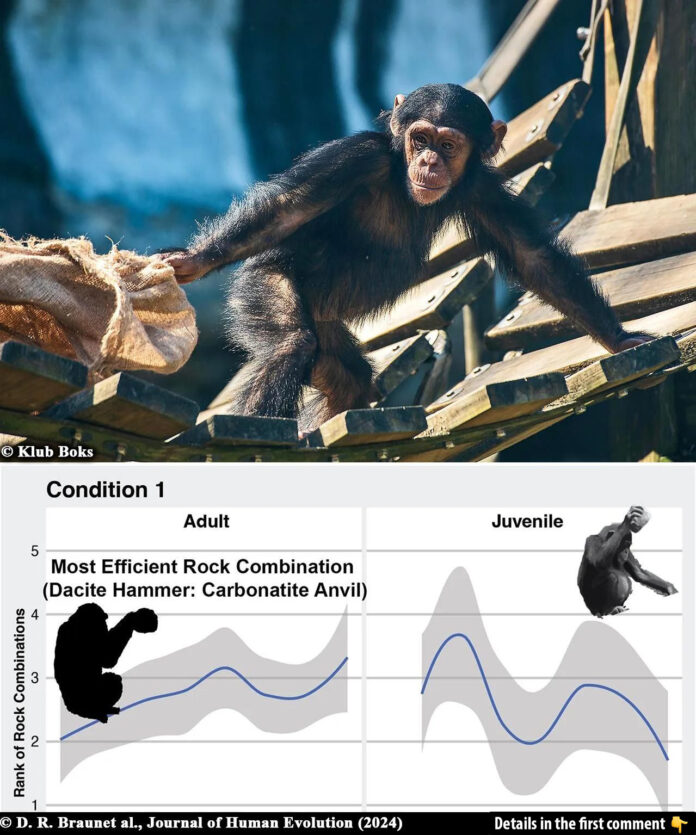Chimpanzees, our closest living relatives, have long captivated researchers with their intelligence and problem-solving abilities. A recent study published in the Journal of Human Evolution has uncovered surprising similarities between how modern chimpanzees and early human ancestors, the Oldowan hominins, chose tools. This research not only sheds light on the evolution of tool use but also provides a deeper understanding of the cognitive and cultural behaviors shared by both species.
Observations from Bossou, Guinea: Decoding Chimpanzee Behavior
In the lush forests of Bossou, Guinea, researchers observed a group of chimpanzees as they cracked nuts using tools. These chimps employed a two-tool method: a hammerstone to break the nut and an anvil to hold it steady. To study their decision-making process, scientists presented the chimps with various stones, differing in hardness, weight, and stability.
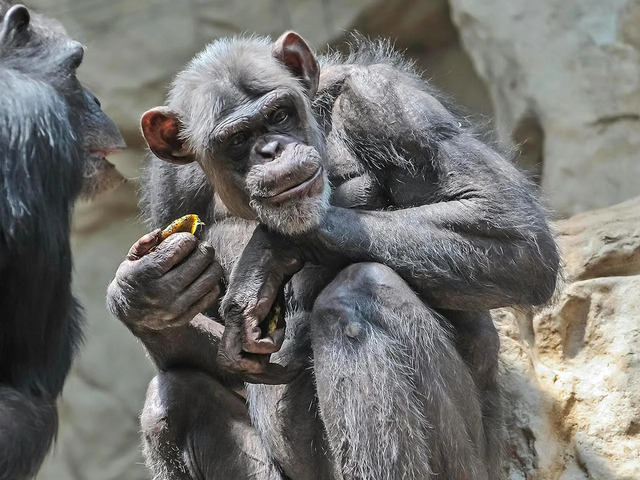
The findings were remarkable. The chimps consistently selected harder stones as hammers and softer, more stable ones as anvils. This deliberate choice indicates that their decisions were not based on superficial qualities like appearance or texture but on the mechanical properties of the stones. Such an approach mirrors the purposeful behavior of early human ancestors when selecting tools for specific tasks.
Video
Watch as chimpanzees use stone tools just like ancient cave men – this amazing video reveals the fascinating connection between our closest relatives and early human behavior!
The Oldowan Connection: Echoes of the Past
Oldowan tools, some of the earliest known in human history, date back approximately 2.5 million years. These tools, crafted and used by early hominins, were essential for activities such as chopping, cutting, and scraping. The process of choosing the right stone for a task was a critical skill, honed over generations.

The similarities between the tool choices of chimps and Oldowan hominins are striking. Both groups prioritized functionality over form, selecting materials that offered the greatest practical benefits. Moreover, evidence shows that Oldowan hominins transported stones over long distances, demonstrating a sophisticated understanding of material properties. This parallels the intentionality observed in the chimps’ selection process, offering a fascinating glimpse into the cognitive capabilities shared by these species.
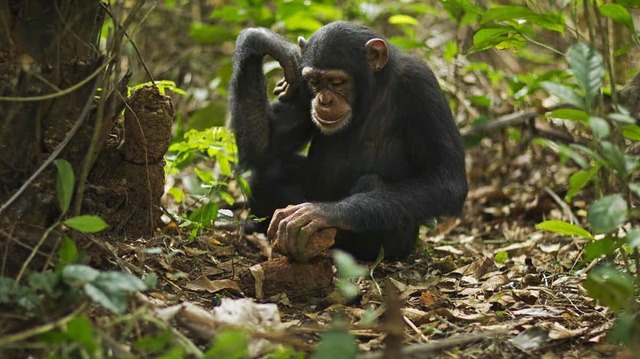
Cultural Transmission Among Chimpanzees: A Social Phenomenon
One of the most intriguing aspects of the study was the observation of cultural transmission among chimpanzees. Younger chimps mimicked the tool choices of older, more experienced members of their group. This behavior suggests that the knowledge of selecting effective tools was passed down socially, much like how early human societies taught survival skills and tool-making techniques.
This form of social learning is a cornerstone of cultural evolution. In early human communities, the ability to share and transmit knowledge played a crucial role in technological advancements. The parallels between chimps and humans in this regard highlight the deep-rooted connections in their social and cognitive development.
The Role of Tools in Human Evolution
The evolution of tool use marked a turning point in human history. For early humans, tools were not merely instruments for survival; they were catalysts for innovation and adaptability. Tools allowed early hominins to process food more efficiently, defend themselves, and adapt to changing environments. This adaptability was key to their survival and eventual dominance as a species.
The study of chimpanzees underscores the importance of tools in shaping not only survival strategies but also social structures. By observing chimps’ tool use, researchers can infer how early humans might have used similar methods to overcome challenges and thrive in diverse environments.
Insights from Primate Archaeology: Bridging the Gap
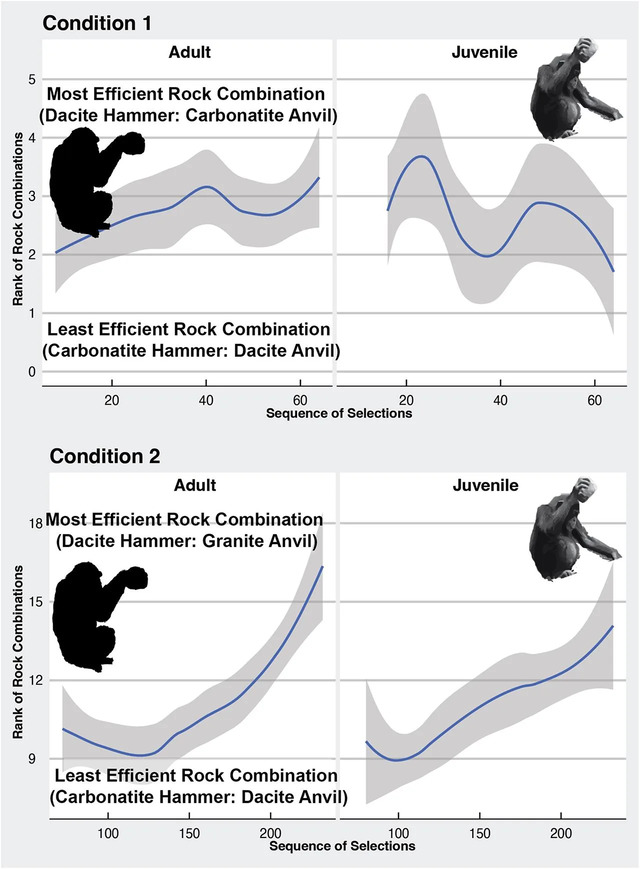
Primate archaeology, a burgeoning field of study, seeks to connect the behaviors of modern primates with the archaeological evidence of ancient hominins. By examining chimpanzees, who share about 98% of their DNA with humans, scientists can reconstruct the social and environmental factors that influenced the emergence of tool use.
This study is a testament to the value of primate archaeology. It not only deepens our understanding of early human behavior but also highlights the cognitive abilities of chimps, offering a unique perspective on the shared evolutionary journey of these two species.
Broader Implications for Evolutionary Studies
The parallels between chimpanzees and early humans extend beyond tool use. They speak to a shared history of problem-solving, innovation, and social learning. By studying modern primates, researchers can gain insights into the behaviors that set the stage for human evolution.
This research also underscores the importance of interdisciplinary approaches, combining paleobiology, anthropology, and behavioral science. Such collaborations are essential for unraveling the complexities of human evolution and the factors that shaped our species.
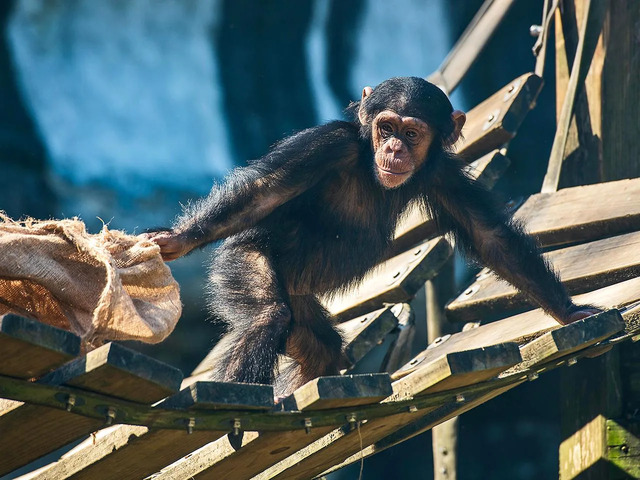
Video
Explore the stone tool technology of our human ancestors in this HHMI BioInteractive video – watch to learn how these early tools shaped the course of human evolution!
Conclusion: A Shared Legacy of Innovation
The study of chimpanzees and their tool-use behaviors offers a fascinating window into the past. By drawing comparisons with early human ancestors, researchers have highlighted the remarkable cognitive and cultural connections between these species. The deliberate choices made by chimps in selecting tools mirror the purposeful behaviors of Oldowan hominins, underscoring the evolutionary roots of innovation and adaptability.
As we continue to explore the behaviors of our closest relatives, we gain not only a deeper understanding of our own evolutionary history but also a renewed appreciation for the intelligence and ingenuity of the animal kingdom. This research serves as a powerful reminder of the shared legacy that binds humans and chimpanzees, rooted in a history of problem-solving, cultural transmission, and the unyielding drive to adapt and thrive.
